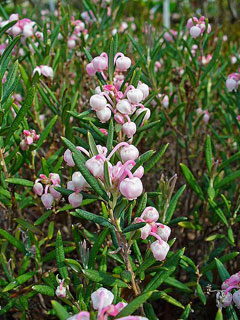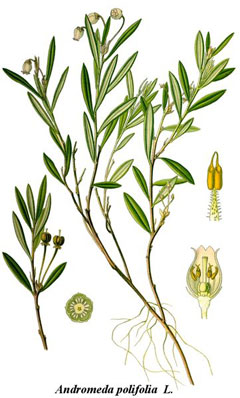 |
|
http://commons.wikimedia.org/wiki/File:Andromeda_polifolia_001.JPG |
 |
| http://commons.wikimedia.org/wiki/File:Cleaned-Illustration_Andromeda_polifolia.jpg |
Translate this page:
Summary
Bloom Color: Pink.
Main Bloom Time: Mid spring. Form: Rounded.
Physical Characteristics

 Andromeda polifolia is an evergreen Shrub growing to 0.3 m (1ft) by 0.6 m (2ft in) at a slow rate.
Andromeda polifolia is an evergreen Shrub growing to 0.3 m (1ft) by 0.6 m (2ft in) at a slow rate.
See above for USDA hardiness. It is hardy to UK zone 2. It is in leaf all year, in flower from May to September. The species is hermaphrodite (has both male and female organs) and is pollinated by Bees, Lepidoptera (Moths & Butterflies). The plant is self-fertile.
Suitable for: light (sandy) and medium (loamy) soils and prefers well-drained soil. Suitable pH: mildly acid soils and can grow in very acid soils.
It can grow in semi-shade (light woodland). It prefers moist or wet soil.
UK Hardiness Map
US Hardiness Map
Synonyms
Plant Habitats
Woodland Garden Dappled Shade; Bog Garden;
Edible Uses
Edible Parts: Shoots
Edible Uses: Tea
The tender leaves and shoot-tips are boiled as an aromatic tea[161, 177]. A delicious drink[183]. Some caution is advised since boiling the plant or infusing it in hot water is said to release a toxic chemical[183]. It is safer to soak the leaves in a jar of water in direct sunlight to make 'sun tea'[183].
References More on Edible Uses
Medicinal Uses
Plants For A Future can not take any responsibility for any adverse effects from the use of plants. Always seek advice from a professional before using a plant medicinally.
Pectoral
The plant is used as a respiratory aid in the treatment of catarrh[257].
References More on Medicinal Uses
The Bookshop: Edible Plant Books
Our Latest books on Perennial Plants For Food Forests and Permaculture Gardens in paperback or digital formats.

Edible Tropical Plants
Food Forest Plants for Hotter Conditions: 250+ Plants For Tropical Food Forests & Permaculture Gardens.
More

Edible Temperate Plants
Plants for Your Food Forest: 500 Plants for Temperate Food Forests & Permaculture Gardens.
More

More Books
PFAF have eight books available in paperback and digital formats. Browse the shop for more information.
Shop Now
Other Uses
Tannin
Tannin is obtained from the leaves and twigs[61].
Special Uses
References More on Other Uses
Cultivation details
Landscape Uses:Border, Container, Rock garden, Specimen. Requires a well-drained, moisture-retentive, lime-free, humus- rich soil and a shady position[133, 182, 200]. Plants spread slowly by means of suckers when they are grown in a suitable position[182]. A very ornamental plant, there are many named varieties[182]. Special Features:North American native, Attractive flowers or blooms.
References Carbon Farming Information and Carbon Sequestration Information
Temperature Converter
Type a value in the Celsius field to convert the value to Fahrenheit:
Fahrenheit:
The PFAF Bookshop
Plants For A Future have a number of books available in paperback and digital form. Book titles include Edible Plants, Edible Perennials, Edible Trees,Edible Shrubs, Woodland Gardening, and Temperate Food Forest Plants. Our new book is Food Forest Plants For Hotter Conditions (Tropical and Sub-Tropical).
Shop Now
Plant Propagation
Seed - sow February/March in an acid compost in the greenhouse. Surface sow or only just cover the seed and place in a lightly shaded position[78, 133]. The seed usually germinates in 1 - 2 months at 12°c[133]. Prick out the young seedlings into individual pots as soon as possible, they are prone to damp-off and so should be kept well ventilated[78]. Grow them on in the greenhouse for at least their first winter and plant them out in early summer once they are 15cm or more tall. Cuttings of half-ripe wood, 5 - 7cm with a heel, July/August in a frame in a shady position. Takes 15 months[78]. Layering in August in a semi-shady position. Takes 18 months[78]. Division in early spring. The plants should be 'dropped' beforehand[78]. This entails digging up the plant 6 to 12 months earlier and replanting it somewhat more deeply. The buried branches will then root and form new plants when divided.
Other Names
If available other names are mentioned here
Native Range
TEMPERATE ASIA: Russian Federation (Buryatia, Tyva, Respublika, Yakutia-Sakha, Altay, Krasnoyarsk, Chita, Irkutsk, Kemerovskaja oblast, Novosibirsk, Omsk, Tomsk, Tyumen), Mongolia, Russian Federation (Kurile Islands, Habarovskij kraj, Primorye, Amur, Kamcatskij kraj, Cukotskij avtonomnyj okrug), Japan (Hokkaidô, Honshu) EUROPE: Denmark, Finland, United Kingdom, Ireland, Norway, Sweden, Austria, Belgium, Switzerland, Germany, Netherlands, Poland, Belarus, Estonia, Lithuania, Latvia, Moldova, Russian Federation (Karelia, Arkhangelsk), Ukraine, Italy, Romania, Slovenia, France
Weed Potential
Right plant wrong place. We are currently updating this section.
Please note that a plant may be invasive in one area but may not in your area so it's worth checking.
Conservation Status
IUCN Red List of Threatened Plants Status :

Growth: S = slow M = medium F = fast. Soil: L = light (sandy) M = medium H = heavy (clay). pH: A = acid N = neutral B = basic (alkaline). Shade: F = full shade S = semi-shade N = no shade. Moisture: D = dry M = Moist We = wet Wa = water.
Now available:
Food Forest Plants for Mediterranean Conditions
350+ Perennial Plants For Mediterranean and Drier Food Forests and Permaculture Gardens.
[Paperback and eBook]
This is the third in Plants For A Future's series of plant guides for food forests tailored to
specific climate zones. Following volumes on temperate and tropical ecosystems, this book focuses
on species suited to Mediterranean conditions—regions with hot, dry summers and cool, wet winters,
often facing the added challenge of climate change.
Read More
Expert comment
Author
L.
Botanical References
1117200
Links / References
For a list of references used on this page please go here
Readers comment
© 2010, Plants For A Future. Plants For A Future is a charitable company limited by guarantee, registered in England and Wales. Charity No. 1057719, Company No. 3204567.